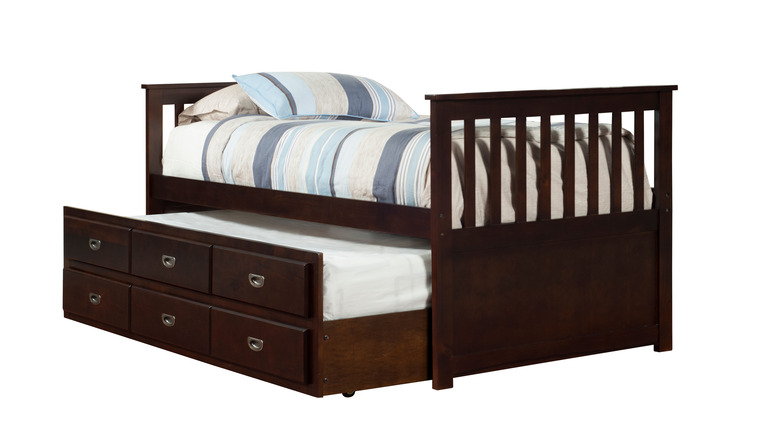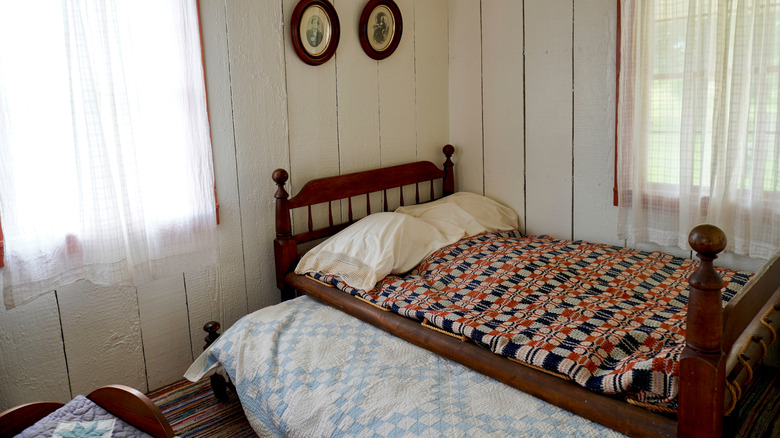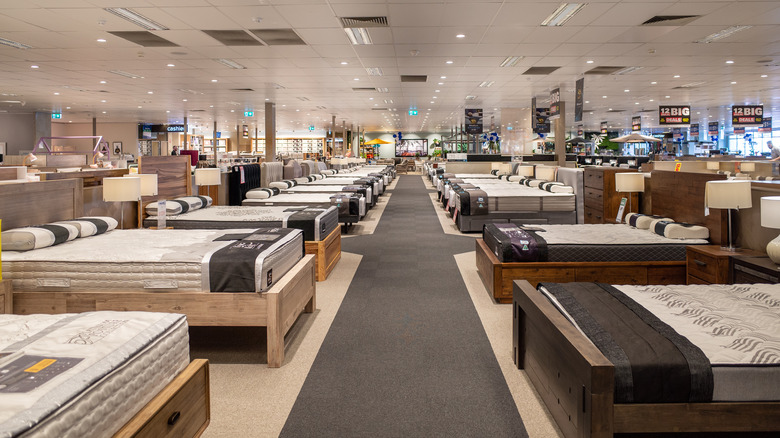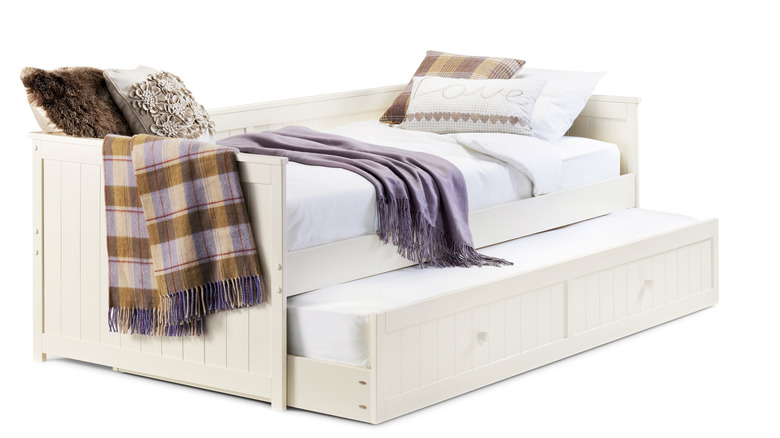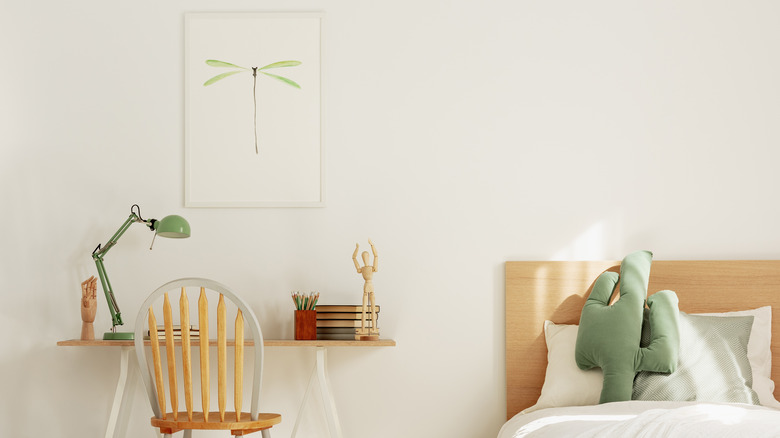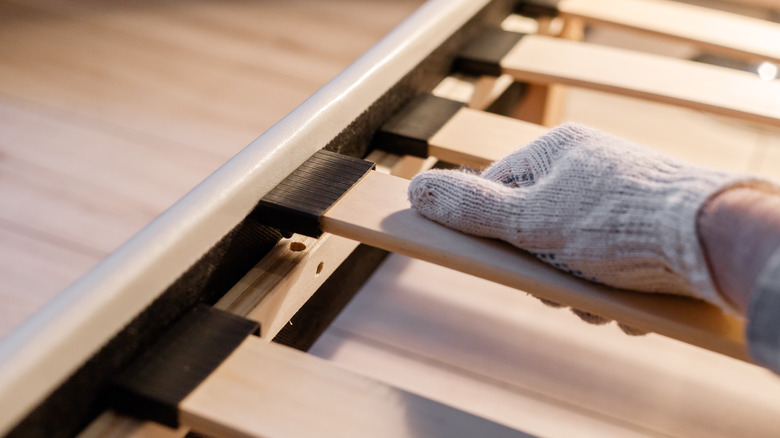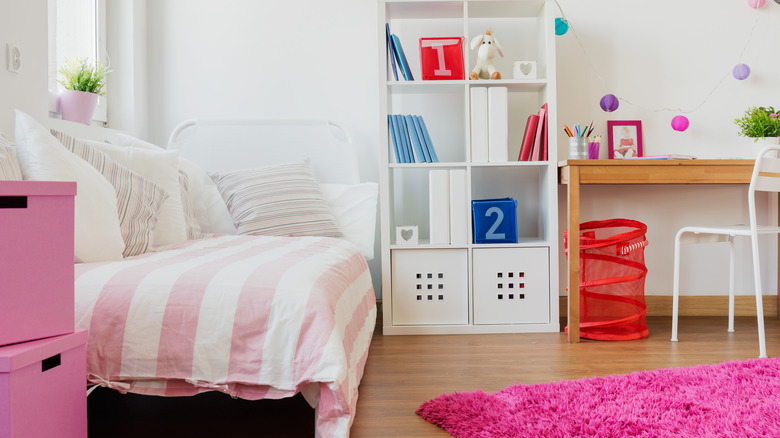Trundle Bed Vs. Daybed: What's The Difference?
Anyone who has lived in a home where space was an issue knows the struggle of picking the right furniture to make the most out of a small area. In terms of beds, you can go many different ways, but for space optimization, some of the most recommended options include trundle beds and daybeds. While they look very similar, they have quite a few differences that set them apart.
The confusing part for many people is that while daybeds can be trundle beds, trundle beds cannot be daybeds. Since a trundle is simply a part of the bed, a daybed can very well include a trundle, per Furniture. To put it plainly, a daybed is a trundle bed without the trundle. Other than the trundle, other elements set both items apart, like size and price, for example. However, the type you should opt for depends on your living situation. That is, whether you live in a house or an apartment, are single or married with or without kids, and even what you want the primary function of the bed to be.
What is the difference in appearance?
The similar appearance of a trundle bed and daybed is what confuses a lot of consumers. A trundle bed is a single-sized, couch-like bed, often with a three-piece headboard. According to the Sleep Foundation, the trundle is the main component and feature that sets a trundle bed apart from other similar beds. They also state that trundle beds typically have wheels to make usage a breeze and space maximization possible. However, when the trundle is stored underneath the frame, a trundle bed and daybed can look precisely the same.
A daybed can sometimes have space underneath it, easily recognizable since it's visibly missing the trundle part. But just like the trundle bed, it has a three-sided design that resembles the arms and back of a couch, enabling it to be used for lounging during the daytime and as a bed at night, per Wayfair. Both beds typically employ pillows for day use. While a daybed can just as easily be twin or double-sized, a trundle bed is often two twin-sized beds — although double-sized trundle beds exist, they are not as common. It's important to note that while daybeds typically do not have trundles, some varieties are designed to have a pull-up or pop-up trundle.
What is the difference in cost?
The price factor won't play a lot in your decision-making process, as they don't vary drastically. According to the MattressNut, a trundle bed generally costs anywhere from $205 to $630, barring customizations and additions. On the other hand, a daybed might be on the lower end of that price range because it doesn't have the trundle feature, which automatically reduces the price.
UpHomely reports that daybeds are sold between $200 and $400, but you can find one for as little as $100 and even lower! If you opt for a daybed with a trundle feature, you can expect the price to go up slightly. The price tag of a daybed and trundle bed can change significantly depending on what you want to get out of your purchase and the design you desire. Added features such as storage, extra sturdiness, and quality upholstery materials can alter the overall cost.
Pros and cons of trundle beds
While trundle beds can be a great option in some instances, there are advantages and disadvantages to consider before purchasing. Regarding pros, perhaps the biggest one yet, trundle beds create more sleeping space without compromising the living area. These beds are commonly used in small studios, children's rooms for sleepovers, or guest rooms that can often double as offices or dens. Trundle beds are the perfect space saver, and as the MattressNut points out, they also offer two beds in one.
A disadvantage is that a trundle bed requires a particular mattress for the trundle part since it is designed to be thinner. Another regards the trundle mattress, which can get dirty easily since it does not get much ventilation when not in use. However, one of the most significant cons of trundle beds is that the trundle eliminates possible storage underneath the bed. Oddly, you are looking to buy a trundle bed to save space, but extra storage under a bed can be very valuable. Finally, it can sometimes be dangerous for kids since their fingers can potentially get stuck in the pull-up or pop-out mechanisms, per MattressNut.
Pros and cons of daybeds
Daybeds also have good and slightly less pleasing things about them. On the one hand, they are perfect for anyone living alone in a small space since they quickly go from bed to couch and don't require you to move any furniture during the transition, like sofa beds probably do. A daybed also eliminates the need to buy additional seating for guests because they tend to be longer than standard couches, says Furnishing Tips. Finally, daybeds are quite budget-friendly since they tend to be cheaper than other couch-bed options.
But they only sleep one person, which is the most significant disadvantage since if this is your bed, you can't have any overnight visitors. If it's a guest bed, it can only take one individual comfortably. Furthermore, if you are the type of person who doesn't make their bed every morning, this might not be the right choice for you since the point is to be able to turn it into a couch during the day.
What are the differences in features?
A trundle, as characterized by Living Spaces, is generally a twin-sized frame on wheels with a relatively thin mattress that is stored underneath the trundle bed when unused and can easily be pulled out to be slept on. This variety of beds can sometimes be a pop-up, meaning that it can be pulled out from underneath the bed and brought up to its level, making it double-sized instead of two twin-sized.
A daybed has a much simpler design, as the standard option does not include a trundle but comprises a space underneath it. Overall, it resembles a couch that can be used for lounging during the day and as a bed at night. Aesthetically, a trundle bed tends to be bulkier than a daybed which is something to keep in mind for your design and home layout. They both, however, generally have a three-piece frame to make them appear couch-like. Finally, the trundle bed requires two mattresses, while the daybed only has one.
Durability and maintenance
Neither one of these beds will get damaged too quickly as they don't require much movement, as is the case with pull-out couches, for example. However, much like any furniture you want to keep in good shape, it's essential to clean your daybed or trundle bed often while being gentle and following the manufacturer's recommendations on maintenance. While a mattress will last up to 10 years, according to the Sleep Foundation, you should be able to keep the bed frame longer.
Concerning trundle beds specifically, if you want your second mattress (the one underneath the bed) to last a decade, you will want to air it out often, especially if you don't use it as much. The rest of the upkeep is straightforward and is nothing you wouldn't do with a regular bed. Remember to take care of spills immediately to avoid permanent stains and smells.
Recommended use for each
The trundle and the daybed can be used for similar purposes, but you might want to go with one instead of the other in some cases. For example, a trundle bed in a child's room might be more appropriate because the trundle is great for sleepovers, as mentioned by The Independent. The design is usually not as sleek as a daybed and looks more appropriate for a kid's room. A trundle bed in this area will also make cuddling your little one more comfortable.
On the other hand, a daybed tends to look better than a trundle bed in a space that is either a guest room or a home office. A daybed usually has a more stylish aesthetic and is perfect for a multi-purpose room that double as a sleeping area. So, you'll also want to consider placing your daybed in the living room if you're working with limited space.
